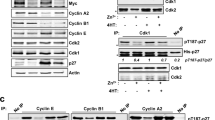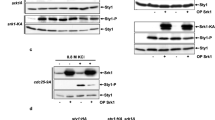Abstract
C-myc availability is central for its ability to serve as a regulator of cell growth and death. Here we study the regulation of c-myc protein stability and identify domains of c-myc that are important for its stabilization in response to stress kinases activated following selective stress conditions. UV-irradiation elicited an increase in c-myc protein levels, which could be attenuated by inhibitors of stress kinases but also by actinomycin D-inhibitor of transcription. Inhibition of protein synthesis results in a noticeable decrease in c-myc levels, further pointing to the short half-life of the protein. However, in combination with tumor necrosis factor-alpha (TNF-α), cycloheximide efficiently increases steady-state levels of c-myc, suggesting that selective stress conditions are required to increase c-myc protein stability. Expression of MEKK1, an upstream regulator of protein kinases that has been implicated in mediating the response to diverse stress conditions, also results in an efficient increase in the half-life of c-myc protein. To map c-myc domains that are responsive to stress kinases, we monitored changes in the level of c-myc deletion mutants following MEKK1 expression. Of the seven c-myc deletion mutants analysed, the domain spanning amino acids 127–189 was found to be required for MEKK1-dependent increase in c-myc stability. In all, the present study identifies a novel domain that is important for the regulation of c-myc stability by stress kinases in response to selective stress conditions.
This is a preview of subscription content, access via your institution
Access options
Subscribe to this journal
Receive 50 print issues and online access
$259.00 per year
only $5.18 per issue
Buy this article
- Purchase on Springer Link
- Instant access to full article PDF
Prices may be subject to local taxes which are calculated during checkout





Similar content being viewed by others
References
Alvarez E, Northwood IC, Gonzalez FA, Latour DA, Seth A, Abate C, Curran T, Davis RJ . 1991 J. Biol. Chem. 266: 15277–15285
Askew DS, Ashmun RA, Simmons BC, Cleveland JL . 1991 Oncogene 6: 1915–1922
Bahram F, von der Lehr N, Cetinkaya C, Larsson LG . 2000 Blood 95: 2104–2110
Baud V, Liu ZG, Bennett B, Suzuki N, Xia Y, Karin M . 1999 Genes Dev. 13: 1297–1308
Blattner C, Kannouche P, Litfin M, Bender K, Rahmsdorf HJ, Angulo JF, Herrlich P . 2000 Mol. Cell Biol. 20: 3616–3625
Bonvini P, Nguyen P, Trepel J, Neckers LM . 1998 Oncogene 16: 131–139
Chen CY, DelGatto-Konczak F, Wu Z, Karin M . 1998 Science 280: 1945–1949
Chen L, Smith L, Accavitti-Loper MA, Omura S, Smith JB . 2000 Arc. Biochem. Biophys. 374: 306–312
Cheng M, Wang D, Roussel MF . 1999 J. Biol. Chem. 274: 6553–6558
Ciechanover A, DiGiuseppe JA, Bercovich B, Orian A, Richter JD, Schwartz AL, Brodeur GM . 1991 PNAS 88: 139–143
Dang CV . 1999 Mol. Cell. Biol. 19: 1–11
Eldar-Finkelman H, Argast GM, Foord O, Fischer EH, Krebs EG . 1996 PNAS 93: 10228–10233
Evan G, Wyllie AH, Gilbert CS, Littlewood TD, Land H, Brooks M, Waters M, Waters CM, Penn LZ, Hancock DC . 1992 Cell 69: 119–128
Flinn EM, Busch CMC, Wright APH . 1998 Mol. Cell. Biol. 18: 5961–5969
Fuchs SY, Fried V, Ronai Z . 1998 Oncogene 17: 1483–1490
Gavine PR, Neil JC, Crouch DH . 1999 Oncogene 18: 7552–7558
Gregory MA, Hann SR . 2000 Mol. Cell. Biol. 20: 2423–2435
Gross-Mesilaty S, Reinstein E, Bercovich B, Tobias KE, Schwartz AL, Kahana C, Ciechanover A . 1998 PNAS 95: 8058–8063
Gupta S, Seth A, Davis R . 1993 PNAS 90: 3216–3220
Henriksson M, Bakardjiev A, Klein G, Luscher B . 1993 Oncogene 8: 3199–3209
Herbst A, Tansey WP . 2001 Mol. Biol. Rep. 27: 203–208
Hoang AT, Lutterbach B, Lewis BC, Yano T, Chou TY, Barret JF, Raffeld M, Hann SR, Dang CV . 1995 Mol. Cell. Biol. 15: 4031–4042
Kim JW, Joe CO, Choi EJ . 2001 J. Biol. Chem. 276: 27064–27070
Li H, Zhu H, Xu CJ, Yuan J . 1998 Cell 94: 491–501
Li L, Nerlov C, Prendergast G, MacGregor D, Ziff EB . 1994 EMBO J. 13: 4070–4079
Luscher B, Eisenman RN . 1988 Mol. Cell. Biol. 8: 2504–2512
Lutterbach B, Hann SR . 1994 Mol. Cell. Biol. 14: 5510–5522
Mateyak MK, Obaya AJ, Adachi S, Sedivy JM . 1997 Cell Growth & Diff. 8: 1039–1048
Minden A, Lin A, McMahon M, Lange-Carter C, Derijard B, Davis RJ, Johnson GL, Karin M . 1994 Science 266: 1719–1723
Noguchi K, Kitanaka C, Yamana H, Kokubu A, Mochizuki T, Kuchino Y . 1999 J. Biol. Chem. 274: 32580–32587
Park IC, Park MJ, Lee SH, Choe TB, Jang JJ, Hong SI . 1998 Cancer Lett. 125: 17–23
Potter M, Marcu KB . 1997 Curr. Top. Micro. Immunol. 224: 1–17
Pulverer BJ, Fisher C, Vousden K, Littlewood T, Evan G, Woodgett JR . 1994 Oncogene 9: 59–70
Salghetti SE, Kim SY, Tansey WP . 1999 EMBO J. 18: 717–726
Sears R, Leone G, DeGregori J, Nevins JR . 1999 Mol. Cell. 3: 169–179
Sears R, Nuckolls F, Haura E, Taya Y, Tamai K, Nevins JR . 2000 Genes Dev. 14: 2501–2514
Seth A, Alvarez E, Gupta S, Davis R . 1991 J. Biol. Chem. 266: 23521–23524
Shi CS, Kehrl JH . 1997 J. Biol. Chem. 272: 32102–32107
Shindo H, Tani E, Matsumuto T, Hashimoto T, Furuyama J . 1993 Acta Neuropathol. (Berl.) 86: 345–352
Spotts GD, Patel SV, Xiao Q, Hann SR . 1997 Mol. Cell. Biol. 17: 1459–1468
Thompson EB . 1998 Annu. Rev. Physiol. 60: 575–600
Waters CM, Littlewood TD, Hancock DC, Moore JP, Evan GI . 1991 Oncogene 6: 797–805
Xiao Q, Claassen G, Shi J, Adachi S, Sedivy J, Hann SR . 1998 Genes Dev. 12: 3803–3808
Yuasa T, Ohno S, Kehrl JH, Kyriakis JM . 1998 J. Biol. Chem. 273: 22681–22692
Yujiri T, Sather S, Fanger GR, Johnson GL . 1998 Science 282: 1911–1914
Acknowledgements
We thank Mitch Goldfarb and Lu Hai Wang for advice, and Zhen Qian Pan, Serge Fuchs and members of the Ronai lab for discussions. We thank Alisa Helfgott for technical assistance. Support from NCI grants (CA85197 to D Alarcon-Vargas; CA78419 to Z Ronai; CA13106 to WP Tansey; a Leukemia and Lymphoma Society Scholar) is greatly acknowledged.
Author information
Authors and Affiliations
Corresponding author
Rights and permissions
About this article
Cite this article
Alarcon-Vargas, D., Tansey, W. & Ronai, Z. Regulation of c-myc stability by selective stress conditions and by MEKK1 requires aa 127–189 of c-myc. Oncogene 21, 4384–4391 (2002). https://doi.org/10.1038/sj.onc.1205543
Received:
Revised:
Accepted:
Published:
Issue Date:
DOI: https://doi.org/10.1038/sj.onc.1205543
Keywords
This article is cited by
-
ROCK has a crucial role in regulating prostate tumor growth through interaction with c-Myc
Oncogene (2014)
-
RING finger-dependent ubiquitination by PRAJA is dependent on TGF-β and potentially defines the functional status of the tumor suppressor ELF
Oncogene (2006)
-
RhoB facilitates c-Myc turnover by supporting efficient nuclear accumulation of GSK-3
Oncogene (2006)
-
The expression of proapoptosis genes is increased in bipolar disorder, but not in schizophrenia
Molecular Psychiatry (2006)
-
Myc pathways provoking cell suicide and cancer
Oncogene (2003)



